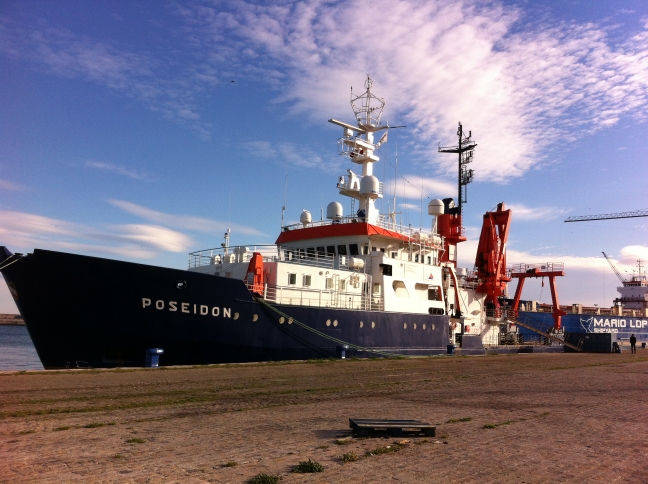
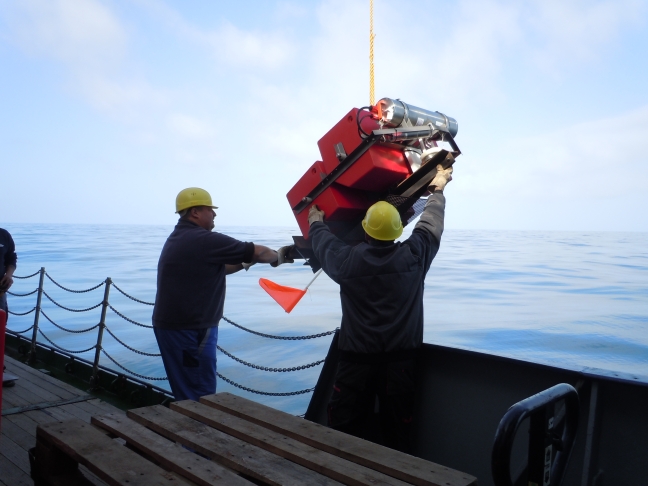
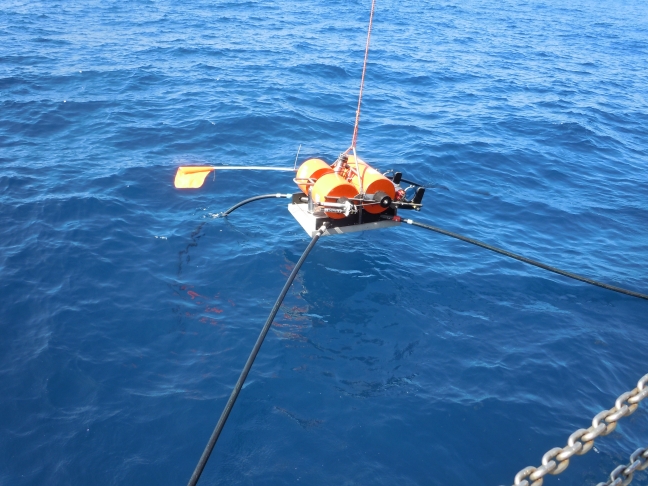
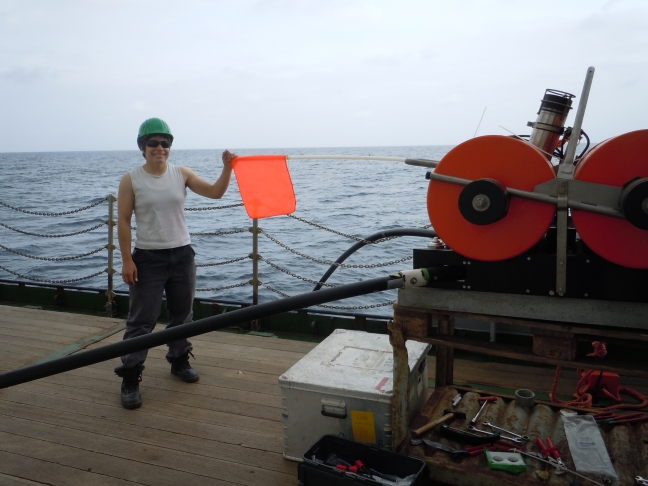
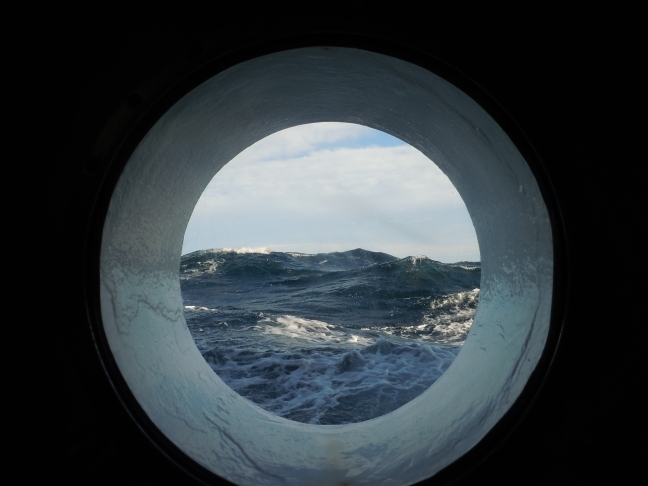
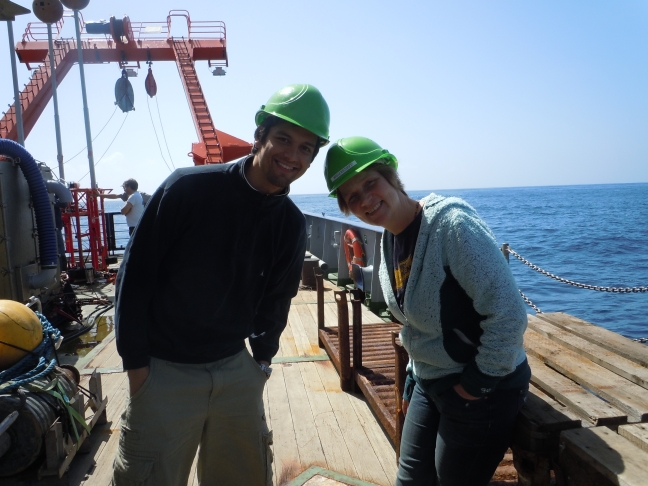
We did it for Science
The story of my first marine geophysical research expedition.






In the spring of 2015, while completing a PhD in marine geophysics, I had the opportunity to work as an assistant on the Poseidon 483 research expedition organized by the GEOMAR institute in Germany. Our mission was to investigate a submarine volcanic complex in the Tyrrhenian Sea, 100 km off the coast of southern Italy. Our team was comprised of 10 scientists and 15 sailors. This is the story of the 18 days we spent at sea.
Part 1: Escape from the Depths!
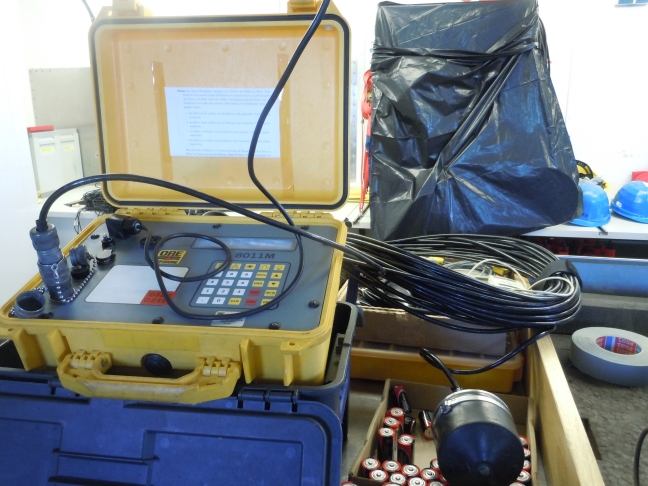
Collecting data on the bottom of the seafloor comes with some complications which I had never considered before. On land, when you set up a geophysical station, you can simply mark its location with GPS. But satellites don't communicate through 700 m of water, and determining the exact locations of your stations on the seafloor is a bit tricky. We have a device called "Posidonia" which can be lowered on a cable. It has an acoustic transponder which "pings" the ship with sound waves and determines its exact distance and direction from the ship (this is the same kind of "pinging" you may remember from media coverage of the search for MH370's black boxes). We know the exact location of our ship from GPS, so we can then determine the exact location of Posidonia. The plan is to lower Posidonia with each station, get a location on the seafloor, then detach Posidonia from the station and haul it back up to the ship on a cable. But first Posidonia has to be calibrated. This is done by actually placing it on the seafloor, leaving it there, and driving the ship around it in a big figure-8. And then you have to go back and pick it up.
By now you may be considering a second major complication of working on the seafloor: If you dump something on the seafloor, how exactly do you pick it up again? All of our stations have big buoyant blocks of foam on them, which allow them to float, and an anchor to make them sink (usually an old iron railroad tie, or a concrete slab for magnetic experiments). Lower them with the anchor, then ditch the anchor when it's time to come home. The anchor can be detached either by "pinging" the release mechanism with an acoustic signal, or if that fails, the anchor is also set to release after a certain amount of time. Once the anchor is released, your fancy experiment comes bobbing back up to the surface, where a radio transponder, strobe light, and big orange flag help you find it. What could go wrong with a plan like that?
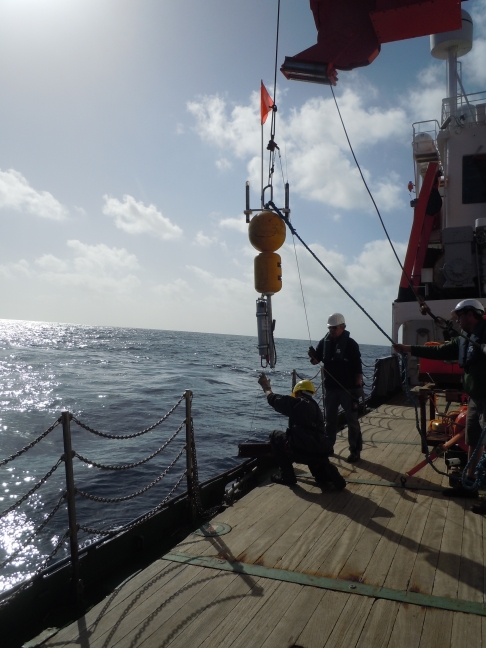
We attach Posidonia to a big buoy float and a railroad tie. At this point one of our technicians, Torge, mentions that the time release mechanism has been disabled on the release hook by whoever used it last, and he can't reset it. This means if the acoustic pinging fails to trigger the release hook, this very expensive and critical piece of equipment will never come back to the surface. Obviously this is cause for concern, but it's a risk we have to take. The crane operator releases Posidonia from the cable, and it is quickly sucked down into the depths. Several big figure-8's later, Posidonia is calibrated and fully functional. Time to release the anchor and bring it back up!
Sebastian sends the release code several times. Posidonia dutifully responds that it has released it's anchor, and it's current distance from the ship is 650 meters. It gives us updates on it's distance every time we ping it. 650 m...650 m...650 m...650 m. Concern begins to mount among the group as it becomes obvious that Posidonia is not, in fact, coming back to the surface. It's stuck, who knows why? Maybe it released the anchor but got tangled up in the anchor cable?
We only have one Posidonia (did I mention it's really expensive?). And we need it for most of the planned experiments on this mission. It's the only way to locate our stations accurately. We could just take GPS measurements at the surface before we drop them, but nothing really falls down straight through 600 meters of water.
Crisis mode. Crisis mode means pretty much everyone on the ship reverts to only speaking German. So I chill out in the lab while the rest of the team has a long discussion in German. Eventually someone tells me that the plan is to try randomly dredging for Posidonia tomorrow morning, as well as sending a camera down to try to look for it. This is the least bad plan anyone can think of, and it's not very likely to work. A better plan in the meantime is to hope that if Posidonia is simply tangled up in the anchor cable, it might eventually break free and come up to the surface on its own. This could happen any time during the night, so people will have to take shifts watching for it overnight. Our chief scientist, Marion, decides that this task should fall to the graduate students. We draw zip ties to decide who gets the 12:30 - 4:30 am shift; Hannah draws the short one. Benedict will stay up until 12:30, and I will get up at 4:30. Time to head to bed early!
When Hannah groggily drags me out of my bunk in the wee hours of the morning, she tells me Posidonia is still transmitting it's distance as approximately 650 m. I head up to the lab and confirm this. I stay awake by reading comics online, which take forever to download via satellite internet. I ping Posidonia again at 5:30 am; still 650 m. At 6:30 am one of the deck hands, Soren, comes down to the deck to help me lower the transponder over the side of the ship for another check. Suddenly, he exclaims, "Come take a look!" and points to the horizon. I squint through the misty dawn, and suddenly I see it too. Bobbing just above the waves a few hundred meters away is a little orange flag! I rush back into the lab and ping Posidonia: 329 m. Posidonia finally decided to come home.
I wake up Marion, who is quite happy with the news. We stand on the deck in the crisp morning air as the ship steers full speed ahead for the flag. The captain expertly navigates the ship alongside Posidonia while a deck hand tosses out a grappling hook and catches it. They pull Posidonia up onto the deck.
One crisis averted. But that, my friends, is only the beginning.
Part 2: Hanging by a Thread
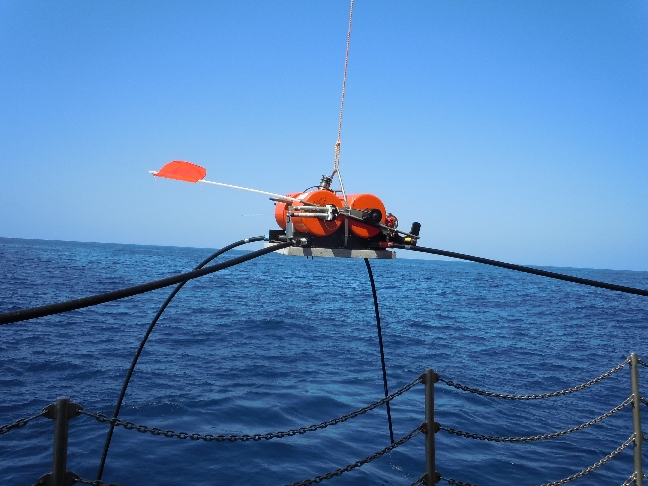
Ok, so here's a quick layman's explanation of electromagnetic (EM) data collection: You have a bunch of receiver stations which you put on the seafloor in different locations around the area you want to study. Then you lower a transmitter on a long cable and tow it around, stopping every 100 meters or so to set it down on the seafloor and transmit an electromagnetic field. This field is measured by the receivers. If there is any electrically conductive material in the seafloor, the electromagnetic field will be affected. So each receiver can sense if there is electrically conductive material in the seafloor between its location and the location of the transmitter. The type of mineral deposit we are looking for, called massive sulfides, are very electrically conductive, so the receivers can detect them.
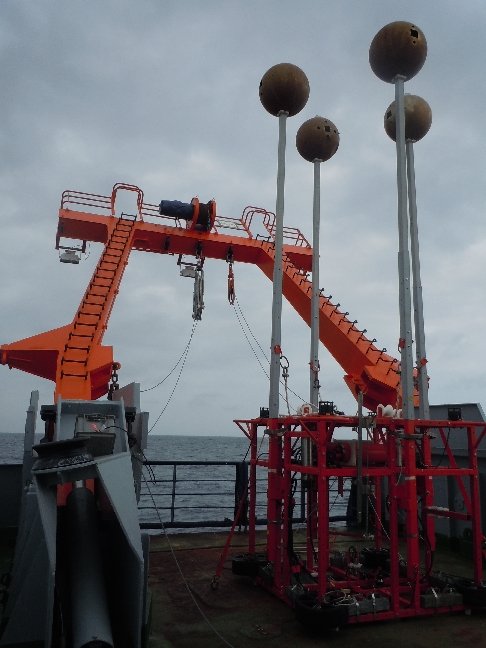
The most difficult part about all of this is that the transmitter has to be really long, because you need to transmit a large electromagnetic field. And big pieces of equipment are difficult to deploy off of a ship. So the group at GEOMAR designed a transmitter with long arms that cleverly fold up while the transmitter is dangling from a cable, and unfold when it is resting on the seafloor and ready to transmit. The arms are 5 meters long and have giant metal spheres on the ends for electrodes. At some point, somebody thought these big metal spheres looked kind of like the Russian Sputnik satellite, so they named the transmitter "Sputnik". (Of course, this might not have been the best choice of name given that the real Sputnik never came back...)
I watch in awe as the experienced crew of deckhands work to lower Sputnik safely into the water; even with the arms folded up, Sputnik is huge and barely fits through the A-frame used to lower it off the back of the ship. With our transmitter in the water, it's time to start transmitting some EM fields and collect some data! We head into the lab and lower Sputnik onto the seafloor. In the last few meters before touching down on the seafloor, the camera mounted on the bottom of Sputnik flashes some brief images of a sandy seabed, and one of our geologists, Mark, excitedly remarks that he can see some shrimp burrows in the sand. Sebastian calls up to the winch operator to let out more slack in the cable so the arms can unfold.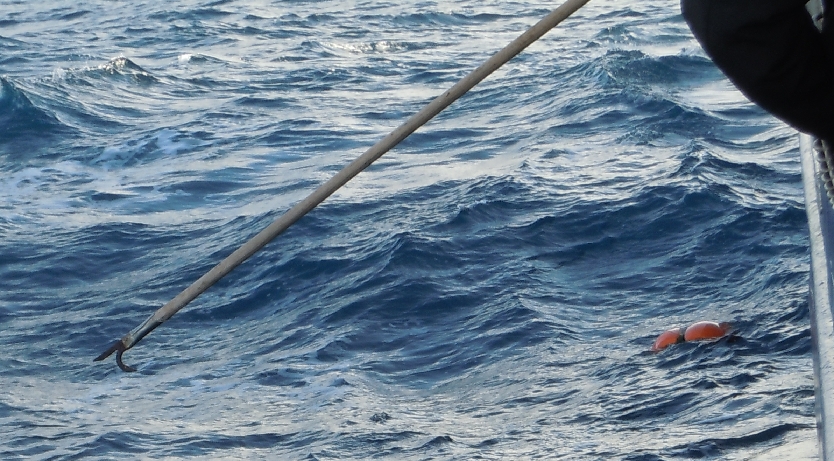
It's right about this time that the captain up on the bridge informs us of something which at first seems to be a very minor problem: one of the "floats" attached to the cable has come off and floated up to the surface. The purpose of these floats is to keep the cable buoyant and taught so it does not get tangled up when we set Sputnik down on the seafloor. There are three floats on the cable, so losing one does not seem like a big deal. The floats are bright orange and shaped like a large egg. As it happens, today is Easter Sunday, and everyone quickly starts making jokes about an Easter egg hunt. We congratulate Soren when he successfully retrieves the "egg" with a long hook on a pole.
This all seems a bit less funny a short while later, after we lose a second float and then Sputnik short circuits and goes dead in the water. The surge from the short circuit also knocks out most of the electronics on the ship, and for a harrowing ten minutes or so we are drifting without power! Fortunately the electricians are able to quickly get the ship up and running again. We begin to haul Sputnik back up to the surface to see what the problem is; the remaining float comes up badly tangled in the cable, which is itself quite mangled in a few places. It seems that the cable isn't stiff enough, and when we set Sputnik down on the seafloor, the slack in the cable can become tangled in the floats. This eventually caused the cable to be badly damaged, exposing the electrical cord in the center (hence the short circuit). And now Sputnik is hanging from a severely damaged cable which could break at any moment and send it plummeting to the seafloor for eternity.
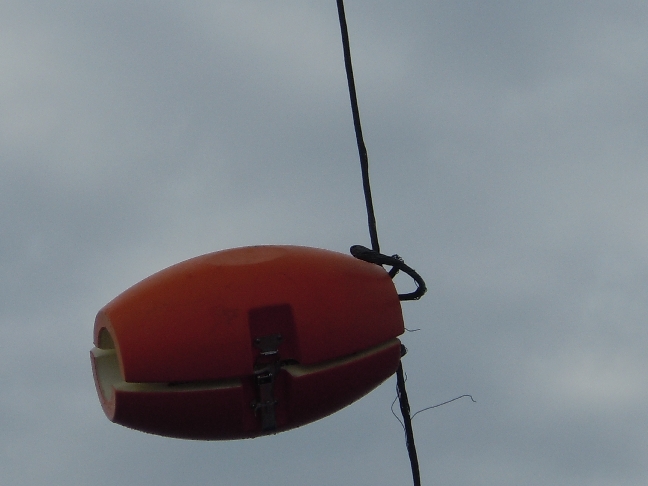
The deck crew hastily come up with a solution to rescue Sputnik. They cannot simply haul it out of the water with the winch, because the mass of cable tangled around the float won't pass through the pulley. Instead they attach a second piece of cable with a loop to the main cable, painstakingly weaving the wire threads around it and crimping it securely in place. Next they attach the ship's crane to the loop and begin to haul the cable up some more. Soon another damaged section of cable emerges from the water where one of the floats was ripped off. My stomach turns when I see how badly damaged the cable is here; Sputnik is hanging by a thread! The crew expertly attaches another loop to the cable and begins to haul it with a second winch. Finally the giant metal spheres of Sputnik's arms begin to emerge from the waves. The damaged cable creaks and crunches as it winds onto the winch. Will it hold long enough to get Sputnik out of the water? The ship heaves up and down in the rough waves as the deck hands scramble to grab onto Sputnik and pull it safely in over the deck without falling into the water themselves. Sputnik swings back and forth precariously on the cable, banging into the hull of the ship several times. Finally it clears the edge of the ship and the men are able to maneuver it safely to a rest on the deck.
Sebastian, Marion, and the technicians rush out to inspect the damage to the transmitter. Fortunately other than some dents and scratches, it appears to be in good shape, and the electronics appear to have survived the short circuit. It's clear, however, that the cable on this ship is not stiff enough to safely lower Sputnik without becoming tangled, at least not while the waves are high and the ship is rocking about. We'll have to put this experiment on hold and hope the weather improves.
Part 3: Carry On, Carry On
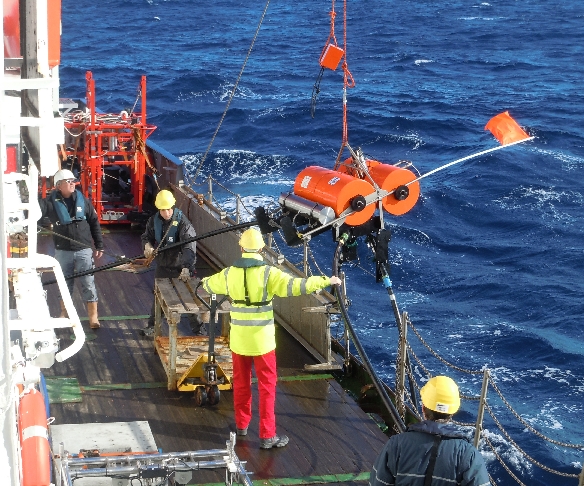
The next day it's the geologists' turn to send a camera down and look for hydrothermal vents. In the meantime, we decide to bring one of the receiver stations up to the surface to take a look at the data. The code is sent to release the anchor for one of the stations, and a few minutes later it pops up above the waves, flag flapping triumphantly in the breeze. As the ship pulls alongside, the deck hands attach the crane and try to pull the receiver up onto the deck. This turns out to be a very difficult task with the limited space we have on deck, and the receiver gets banged around quite a bit, which Sebastian is none too happy about. When the receiver is finally safely strapped down on deck, we remove the data logger, and Sebastian starts to download the data. Then he mutters a word in German which I've heard a few times before on this expedition; I'm pretty sure it's a curse word.
It turns out that due to a problem with the data logger, it only recorded a few hours of data. Losing data from one station is not too big of a deal, but we don't have any way of knowing for sure if the other receivers worked. We could bring them all up to the surface, but we don't have enough spare anchors to put them all back down again. For now all we can do is hope that the other receivers are working properly.
Meanwhile, the geologist experience a similar disappointment; they take footage of an area which appeared in the bathymetric data to have some tall chimney structures, indicative of a hydrothermal vent. But in watching the video they conclude that these structures are only large corals, and there is no evidence of venting. To make matters even worse, a serious mistake has been discovered with the seismic experiment: the seismometers were supposed to stay on the seafloor for several weeks and be picked up by the next expedition, but nobody remembered to disable the time-release mechanism on the anchors. So the seismometers will automatically come back up to the surface in a few days, far sooner than they are supposed to. A somewhat gloomy mood sets in; it seems like nothing is going well.
Science is a profession which often requires improvisation. Mark and Sven may have preferred to find a big hydrothermal vent, but now they sit down after dinner and begin planning a paper they will write on the interesting corals they found. Sebastian and Marion begin to devise a way to modify some of our equipment to collect self-potential data while we wait for the weather to improve, and soon everyone is excited about carrying out this new experiment. After dinner someone turns on the satellite TV in the mess room and most of the group gathers around to drink beer and watch football (that's soccer to us Americans). Out on the deck, Marion and Martin dance to jazz music under the stars of a cool Mediterranean night.
And so we carry on!
Part 4: A Fiery EndingThe weather stays rough for days. The boat rocks about in the white-capped waves, which occasionally come crashing across the deck, driven by a cold, steady wind. One day while I'm outside working to modify Sputnik for collecting self-potential data, a massive wave sloshes up over the side of the boat, soaking me up to my waist and nearly washing my tools overboard. We strip Sputnik of its precariously long arms, replacing them with shorter arms and small electrodes, sufficient for self-potential measurements. Self-potential, in case you are wondering, is just a measurement of the naturally occurring electrical fields close to the seafloor which can be generated by some mineral deposits. We have no idea if we'll find any self-potential fields here, but it seems worth a try, and with the bad weather we can't do much else.
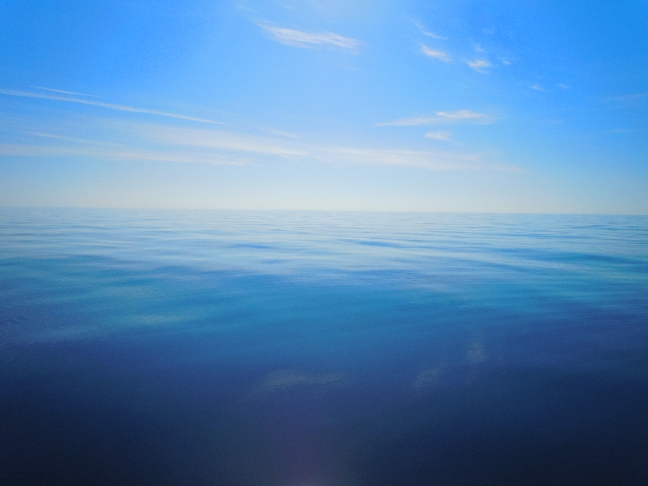
We lower our modified Sputnik on a cable until it's just a few meters above the seafloor and tow it back and forth over the entire volcanic complex. The survey goes well, and a first look at the data suggests several possible anomalies, spikes in the self-potential which may be related to mineralization. I'm quite pleased when Marion tells me that, since no one really planned this experiment in advance, they are willing to give me all the data to process and use as part of my thesis. I have my first geophysical data set!
The next morning I wake up, and everything feels different. I've become so accustomed to constantly rocking back and forth, but now the boat is oddly still, and bright light streams in through the cabin porthole. I walk out on the deck and I'm awed by the sight of calm, gently undulating water stretching as far as the eye can see in all directions. The morning sun reflects brilliantly off the glassy smooth surface. It doesn't seem real.
We jump at the opportunity to make another attempt at collecting EM data. Sputnik, with its long arms and giant spherical electrodes reattached, is lowered into the sea once more. The calm water seems to help, and at first everything is going well. We collect data for about 8 hours, followed by another mangled cable and another harrowing technical rescue. There won't be a third try. By now we've explored enough locations to have a decent data set. It may not be everything we hoped for, but it will suffice. That is, of course, assuming our receivers actually recorded data. Time to bring them back up to the surface and find out.
Our final day on site is a fast-paced recovery operation. One by one, we transmit codes for each receiver to release its anchor, and one by one they appear, tiny specks of orange bobbing in a glassy smooth infinity of blue. In a matter of hours we have them all on deck; no receiver left behind! Sebastian pulls the SD cards from the data loggers and begins to download them. They didn't all work correctly, but to my great relief at least some of them recorded data. It will be a small data set, but it's something. What we learn from the EM and self-potential data we gathered on this cruise will form a substantial portion of my thesis.
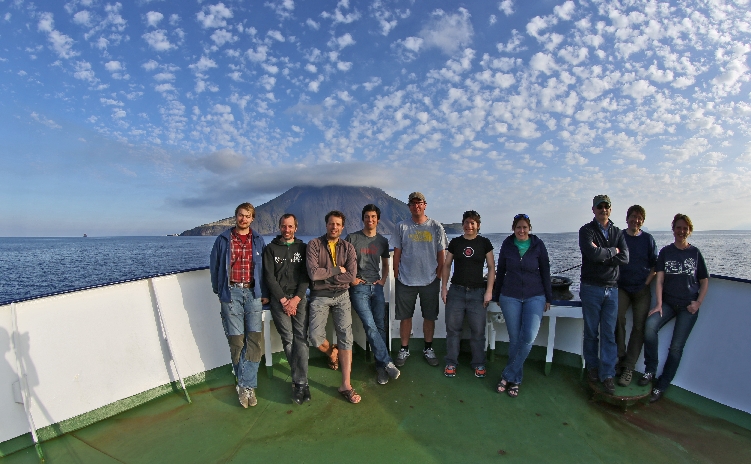
Our work completed, the captain puts the ship into full throttle, and we steer for the Island of Stromboli. Perhaps you've heard of this small Italian island. It consists of a large active volcano and, well, that's all really. The entire island is a massive volcano. Five hours later, our ship is parked very close (but not too close) to its base. Thick white steam puffs from the top as we watch. We drink beer and feast on German sausage, cheese, and bread as the sun goes down in the shadow of Stromboli. Every once in a while, our conversation is interrupted by a faint rumbling in the distance as a new puff of steam ascends from the summit. As darkness falls, the puffs of steam are accompanied by a faint orange glow emanating from the caldera. After several hours, Stromboli finally rewards our patient vigil, and we all cheer when it erupts a small spattering of bright orange lava into the starry night sky.
There is an art to science. Complex experiments rarely go exactly as planned. Science requires us to be patient, to adapt to adverse conditions, to try again and again. Mother nature does not easily give up her secrets, but the secrets are there to be found by those who persist. We reached deep into an ocean of mystery and plucked a few clues from the bottom; tiny bits of knowledge plumbed from the depths where so much more waits to be discovered.
-Roxana Safipour
(rsafipou@mines.edu)